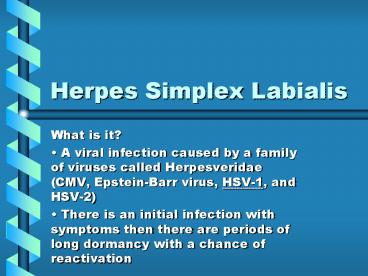Herpes Simplex Labialis - PowerPoint PPT Presentation
1 / 23
Title:
Herpes Simplex Labialis
Description:
Herpes Simplex Labialis. What is it? A viral infection caused by a family of viruses called Herpesveridae (CMV, ... There is an initial infection with symptoms ... – PowerPoint PPT presentation
Number of Views:1360
Avg rating:3.0/5.0
Title: Herpes Simplex Labialis
1
Herpes Simplex Labialis
- What is it?
- A viral infection caused by a family of viruses
called Herpesveridae (CMV, Epstein-Barr virus,
HSV-1, and HSV-2) - There is an initial infection with symptoms then
there are periods of long dormancy with a chance
of reactivation
2
3
HSL
- Who has it?
- In America 80 of the population have HSL. Of
this, about 50 will have reactivation of the
virus at least once in their lifetime. - Primary infection usually occurs in childhood.
4
HSL continued
- How is the virus contracted?
- Via direct contact.
- Explain the pahophysiology?
- The virus enters the host through either a break
in the skin or intact mucus membrane. The virus
invades sensory neurons and is transported to the
sensory ganglia where it lies dormant.
5
HSL continued
- What are the symptoms?
- At first there is a burning, itching, tingling
sensation in the area where the lesion will form. - There can also be pain, fever, swollen lymph
nodes, and malaise. - The lesion appears as small red papules with
fluid containing vesicle 1-3mm in diameter.
6
HSL continued
- The boarder around the vesicle may be red and
inflamed. - Fully developed lesions has a crusty cover and
if there is pus under the crust that may indicate
a secondary bacterial infection. - The whole symptomatic process typically lasts
10-14 days and heals without scarring.
7
HSL continued
- What triggers reactivate virus?
- UV radiation, stress, fatigue, cold burn, wind
burn, fever, injury, menstruation, dental
procedures, infectious disease, and
immunosuppresion.
8
HSL continued
- Side note Acute Herpetic Gingivostomatits (AHG)
- Very similar to HSL, seen mostly in children and
immunocompromised adults - Lesions develop on any oral mucosal surface thus
it resembles RAS.
9
HSL continued
- The distinguishing difference is that AHG
presents itself as infected gums which are red
and covered by a pseudomembrane or studded with
ulcerations. - When are you not to treat HSL?
- Lesions that have lasted longer than 14 days.
10
HSL continued
- Reoccurrence rate increasing in frequency.
- Immunocompromised patients.
- What are the treatment goals?
- To relieve discomfort.
- To prevent secondary bacterial infection.
11
HSL continued
- To prevent autoinoculation or spreading of the
virus. - How do you treat HSL?
- Lesions should be gently washed with mild soap
solution and hands should be washed frequently. - Lesions should be kept moist to prevent drying
or cracking.
12
HSL continued
- Doconasol 10 (Abreva) is the only otc product
proven to reduce the severity and duration of
symptoms. Or is it? - All other otc products just relieve the
discomfort - -Benzocaine (5-20)
- -Dibucaine (0.25-1)
- -Dyclonine HCl (0.5-1)
13
HSL continued
- -Benzyl alcohol (10-33)
- -Camphor (0.1-1)
- -Menthol (0.1-1)
- Topical steroids contraindicated.
- What other therapy is available?
- Orally administered doses of lactobacillus,
L-lysine, citrus bioflavonoid, or pyridoxine.
14
HSL continued
- Do not recommend any of these products, there is
just not enough evidence. - So what is in the formulary?
- Abreva (doconasol 10)
- Novitra (zincum oxydatum 2X, HPUS)
15
HSL continued
- Tanac (Benzalkonium Cl 0.12 Benzocaine 10)
- Zilactin (Benzyl Alcohol 10)
- Chapstick medicated Lip balm stick (camphor 1,
menthol 0.6, phenol 0.5)
16
Xerostomia
- What is it?
- Disorder where the salivary flow is limited or
completely inhibited this results in dry mouth. - Who has it?
- Individuals with certain disease states
(diabetes mellitus, Crohns disease, etc.)
17
Xerostomia continued
- Certain medications
- Radiations therapy of the head and neck
- lifestyle activities (alcohol, tobacco, and
caffeine) - Roughly 20 of the elderly have dry mouth.
18
Xerostomia continued
- So why is dry mouth dangerous?
- Increases the chance of caries, gingivitis,
periodontal disease, reduced denture wearing,
candidiosis, tooth erosion, decalcification, and
decay.
19
Xerostomia continued
- What are the symptoms?
- Difficulty in talking, swallowing, stomatitis,
burning tongue, halitosis, loss of appetite, and
hypersensitive teeth. - What are the goals of treatment?
- To reduce discomfort.
- To reduce risk of dental decay.
20
Xerostomia continued
- When are you not to treat?
- Mouth soreness associated with poor-fitting
dentures. - Fever or Swelling
- Loose teeth or bleeding gums
- Severe tooth pain and any other serious
complication associated with dry mouth.
21
Xerostomia continued
- How are you to treat Xerostomia?
- Avoid substances that reduce salivation.
- Take medications that can dry your mouth one
hour prior to eating. - limit foods high in sugar and acid to prevent
tooth decay.
22
Xerostomia continued
- Chewing gum stimulates salivary flow.
- Use of soft toothbrush to help prevent tooth
decay. - Use of artificial saliva products for as needed
basis. - Artificial saliva is formulated to act as
natural saliva both chemically and physically.
23
Xerostomia continued
- Patients susceptible to caries should also use a
topical fluoride product. - What is in the formulary?
- X-ero-lube
- Oral balance Gel
- Salivart































